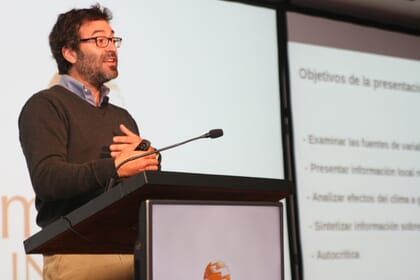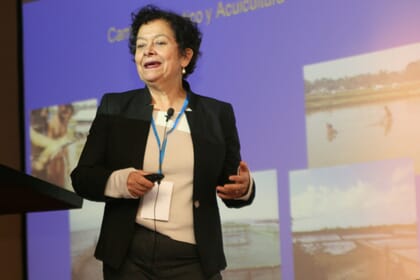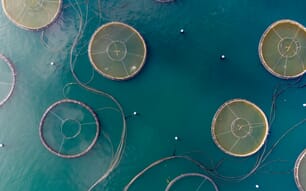During Chile’s largest scientific conference about salmon farming, ‘Jornadas de Salmonicultura’, which took place on June 9th, four speakers addressed climate change. Organised by the Salmon Technology Institute (Intesal), the discussions began with Dr René Garreaud, a professor at University of Chile. Almost 40,000 tonnes of farmed salmonids were lost in Chile due to Harmful Algal Blooms (HABs) in early 2016 and he said that those blooms were probably of both climatic and anthropogenic origin. One of three strongest El Niño-Southern Oscillations (ENSOs) in the last 50 years coincided with the Southern Annular Mode (SAM) in Q1 2016, leading to 70% lower levels of precipitation in some parts of Chilean Patagonia. Regarding predictions for the future, Garreaud expects Chilean Patagonia to experience reduced precipitation and higher surface temperatures. These variations would be of even larger magnitude in the Northern Hemisphere, he added.

© Christian Perez
Dr Bernardo Broitman, a researcher at the Center for Advanced Research in Arid Zones (Ceaza), then presented data from inter-annual, seasonal and intra-seasonal variations in northern Patagonia, based on satellite imaging (Modis) and information mandatorily collected by mussel farmers in the country.
Meanwhile, the technical arm of the Chilean salmon producers, Intesal, took the opportunity to launch a public online platform with data collected from the farming sites of its members, in a move that might potentially conclude in a collaborative work with the team headed by Bernardo Broitman. The Intesal website is designed to allow the sharing of relevant information for monitoring purposes. This includes total phytoplankton levels, chlorophyll concentration and the presence of HABs – especially Alexandrium catenella, which produces a toxin that can cause paralytic shellfish poisoning (PSP).
“The objective of this project is to inform the community and the production companies about the state of phytoplankton conditions in the southern regions of Chile. In this way, we believe that all coastal users will be able to plan their work more accurately. This idea was born as a need to protect the Chilean salmon industry against Harmful Algal Blooms and today we extend that need to offer technical information to the community,” said Alfredo Tello, general manager of Intesal.
Vulnerability and regulation
Subsequently, Dr Doris Soto, a researcher at the Interdisciplinary Center for Aquaculture Research (Incar), presented some possible strategies for the aquaculture industry to adapt to climate change. Likewise, she also shared some details about the vulnerability assessment to climate change for the salmon industry currently being built by Incar, Intesal and other collaborators, which expects to conclude its evaluation matrix within the coming months and should present its first preliminary results next year.
Finally, Dr Gustavo San Martín, commissioner for climate change at the Undersecretary of Fisheries (Subpesca), revealed parts of Subpesca’s developing plan for how the fisheries and aquaculture sector should adapt to climate change. Among other measures, this plan recommends a precautionary and ecosystem-based approach and the need to develop research and improve knowledge regarding climate change. He also emphasized how spreading that knowledge, enhancing the regulatory, political and administrative framework and developing adaptation measures intended to reduce vulnerability were vital.

© Christian Perez.




